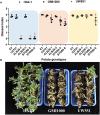Complete Genome Sequence of Sequevar 14M Ralstonia solanacearum Strain HA4-1 Reveals Novel Type III Effectors Acquired Through Horizontal Gene Transfer
- PMID: 31474968
- PMCID: PMC6703095
- DOI: 10.3389/fmicb.2019.01893
Complete Genome Sequence of Sequevar 14M Ralstonia solanacearum Strain HA4-1 Reveals Novel Type III Effectors Acquired Through Horizontal Gene Transfer
Abstract
Ralstonia solanacearum, which causes bacterial wilt in a broad range of plants, is considered a "species complex" due to its significant genetic diversity. Recently, we have isolated a new R. solanacearum strain HA4-1 from Hong'an county in Hubei province of China and identified it being phylotype I, sequevar 14M (phylotype I-14M). Interestingly, we found that it can cause various disease symptoms among different potato genotypes and display different pathogenic behavior compared to a phylogenetically related strain, GMI1000. To dissect the pathogenic mechanisms of HA4-1, we sequenced its whole genome by combined sequencing technologies including Illumina HiSeq2000, PacBio RS II, and BAC-end sequencing. Genome assembly results revealed the presence of a conventional chromosome, a megaplasmid as well as a 143 kb plasmid in HA4-1. Comparative genome analysis between HA4-1 and GMI1000 shows high conservation of the general virulence factors such as secretion systems, motility, exopolysaccharides (EPS), and key regulatory factors, but significant variation in the repertoire and structure of type III effectors, which could be the determinants of their differential pathogenesis in certain potato species or genotypes. We have identified two novel type III effectors that were probably acquired through horizontal gene transfer (HGT). These novel R. solanacearum effectors display homology to several YopJ and XopAC family members. We named them as RipBR and RipBS. Notably, the copy of RipBR on the plasmid is a pseudogene, while the other on the megaplasmid is normal. For RipBS, there are three copies located in the megaplasmid and plasmid, respectively. Our results have not only enriched the genome information on R. solanacearum species complex by sequencing the first sequevar 14M strain and the largest plasmid reported in R. solanacearum to date but also revealed the variation in the repertoire of type III effectors. This will greatly contribute to the future studies on the pathogenic evolution, host adaptation, and interaction between R. solanacearum and potato.
Keywords: Ralstonia solanacearum; genome sequencing; plasmid; potato; type III effectors.
Figures







Similar articles
-
Complete Genome Sequence Analysis of Ralstonia solanacearum Strain PeaFJ1 Provides Insights Into Its Strong Virulence in Peanut Plants.Front Microbiol. 2022 Feb 23;13:830900. doi: 10.3389/fmicb.2022.830900. eCollection 2022. Front Microbiol. 2022. PMID: 35273586 Free PMC article.
-
Comparative genomic analysis of Ralstonia solanacearum reveals candidate avirulence effectors in HA4-1 triggering wild potato immunity.Front Plant Sci. 2023 Feb 23;14:1075042. doi: 10.3389/fpls.2023.1075042. eCollection 2023. Front Plant Sci. 2023. PMID: 36909411 Free PMC article.
-
Comprehensive genome sequence analysis of Ralstonia solanacearum gd-2, a phylotype I sequevar 15 strain collected from a tobacco bacterial phytopathogen.Front Microbiol. 2024 Mar 14;15:1335081. doi: 10.3389/fmicb.2024.1335081. eCollection 2024. Front Microbiol. 2024. PMID: 38550868 Free PMC article.
-
Ralstonia solanacearum, a widespread bacterial plant pathogen in the post-genomic era.Mol Plant Pathol. 2013 Sep;14(7):651-62. doi: 10.1111/mpp.12038. Epub 2013 May 30. Mol Plant Pathol. 2013. PMID: 23718203 Free PMC article. Review.
-
Lessons learned from the genome analysis of ralstonia solanacearum.Annu Rev Phytopathol. 2004;42:107-34. doi: 10.1146/annurev.phyto.42.011204.104301. Annu Rev Phytopathol. 2004. PMID: 15283662 Review.
Cited by
-
Complete Genome Sequence Analysis of Ralstonia solanacearum Strain PeaFJ1 Provides Insights Into Its Strong Virulence in Peanut Plants.Front Microbiol. 2022 Feb 23;13:830900. doi: 10.3389/fmicb.2022.830900. eCollection 2022. Front Microbiol. 2022. PMID: 35273586 Free PMC article.
-
Comprehensive genome sequence analysis of the devastating tobacco bacterial phytopathogen Ralstonia solanacearum strain FJ1003.Front Genet. 2022 Aug 22;13:966092. doi: 10.3389/fgene.2022.966092. eCollection 2022. Front Genet. 2022. PMID: 36072670 Free PMC article.
-
Comparative genomic analysis of Ralstonia solanacearum reveals candidate avirulence effectors in HA4-1 triggering wild potato immunity.Front Plant Sci. 2023 Feb 23;14:1075042. doi: 10.3389/fpls.2023.1075042. eCollection 2023. Front Plant Sci. 2023. PMID: 36909411 Free PMC article.
-
Global Map of Specialized Metabolites Encoded in Prokaryotic Plasmids.Microbiol Spectr. 2023 Aug 17;11(4):e0152323. doi: 10.1128/spectrum.01523-23. Epub 2023 Jun 13. Microbiol Spectr. 2023. PMID: 37310275 Free PMC article.
-
Comprehensive Analysis Reveals the Genetic and Pathogenic Diversity of Ralstonia solanacearum Species Complex and Benefits Its Taxonomic Classification.Front Microbiol. 2022 May 6;13:854792. doi: 10.3389/fmicb.2022.854792. eCollection 2022. Front Microbiol. 2022. PMID: 35602040 Free PMC article.
References
-
- Al-Saadi A., Reddy J. D., Duan Y. P., Brunings A. M., Yuan Q., Gabriel D. W. (2007). All five host-range variants of Xanthomonas citri carry one pthA homolog with 17.5 repeats that determines pathogenicity on citrus, but none determine host-range variation. Mol. Plant Microbe Interact. 20 934–943. 10.1094/MPMI-20-8-0934 - DOI - PubMed
-
- Bertolla F., Frostegård Å, Brito B., Nesme X., Simonet P. (1999). During infection of its host, the plant pathogen Ralstonia solanacearum naturally develops a state of competence and exchanges genetic material. Mol. Plant Microbe Interact. 12 467–472. 10.1094/MPMI.1999.12.5.467 - DOI
-
- Boucher C. A., Barberis P. A., Demery D. A. (1985). Transposon mutagenesis of Pseudomonas solanacearum: isolation of Tn5-induced avirulent mutants. Microbiology 131 2449–2457. 10.1099/00221287-131-9-2449 - DOI
LinkOut - more resources
Full Text Sources

